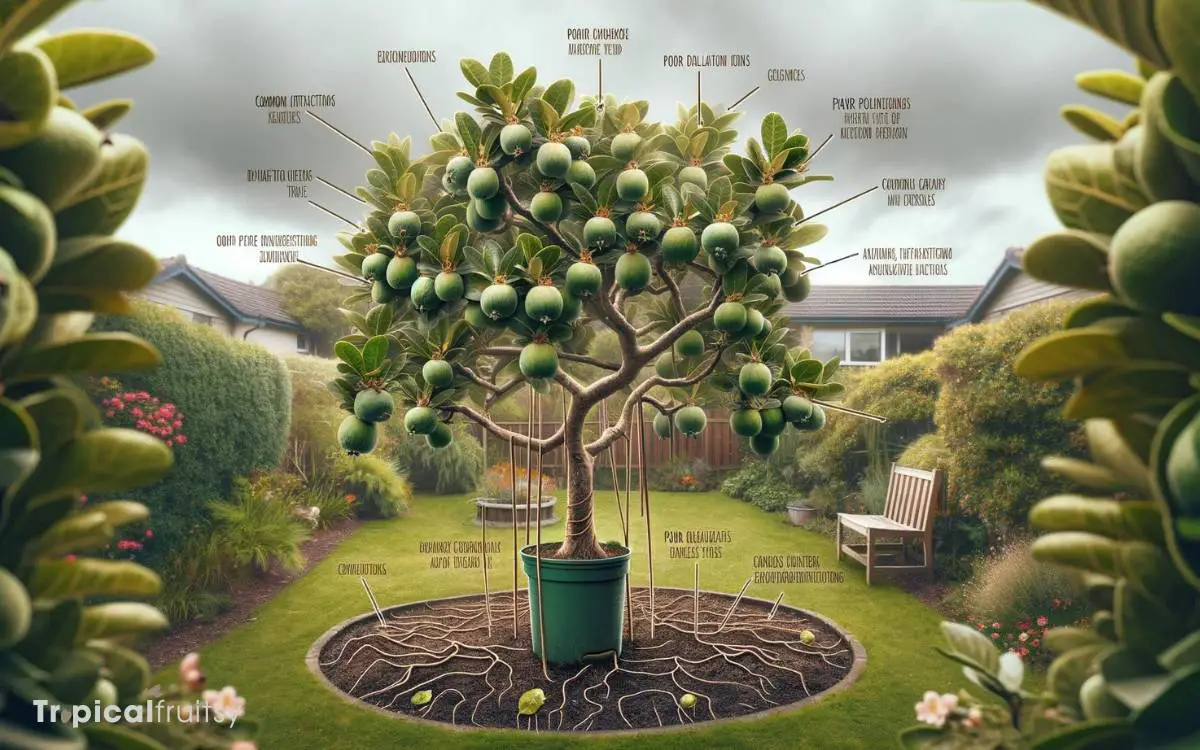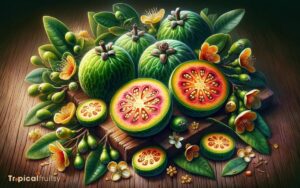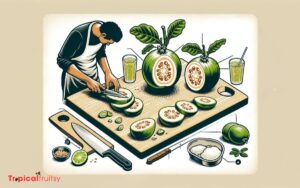Why Is My Feijoa Not Fruiting? Fruitful Mysteries Unlocked!
If your feijoa isn’t fruiting, it could be due to a range of factors including inadequate pollination, youth of the plant, unsuitable climate, poor soil conditions, improper pruning, or even pest and disease issues.
Ensuring cross-pollination with another feijoa variety, adjusting care, and providing optimal growing conditions can help promote fruiting.
Feijoas, also known as pineapple guavas, are unique and flavorful fruits, but sometimes they fail to produce a crop.
Here are some common reasons why a feijoa might not be fruiting:
A gardener with a single feijoa plant in a temperate climate might not see fruit due to lack of cross-pollination. Adding a second feijoa variety

Key Takeaway
Understanding Feijoa Pollination
Many feijoa trees fail to bear fruit due to inadequate pollination, a crucial step in their reproductive process.
Pollination in feijoas is primarily entomophilous, meaning it relies on insects, particularly birds and bees, for the transfer of pollen from male to female flowers.
The unique structure of feijoa flowers necessitates a specific pollination method, referred to as ‘brushing’, by which pollinators physically touch the stamens and stigma, facilitating the transfer of pollen grains.
For successful fertilization, the genetic material within the pollen must be compatible with the female ovule. Diverse plantings encourage cross-pollination, significantly enhancing fruit set.
Gardeners must ensure the presence of cross-compatible varieties and create an environment conducive to pollinator activity to overcome pollination challenges and secure fruit production.
Assessing Plant Age
Feijoas don’t start bearing fruit until they’ve matured, typically taking several years to reach reproductive age. Gardeners should assess the age of their feijoa plants to determine if they should be producing fruit yet.
Age-related fruiting factors:
- Juvenile phase: Feijoas can take 3-5 years before flowering and fruiting commence.
- Mature phase: Optimal fruit production often begins after the 5-year mark.
Understanding a feijoa’s lifecycle is crucial for diagnosing fruiting issues. If a plant isn’t fruiting and is within the juvenile phase, patience is required.
However, if the plant surpasses maturity without bearing fruit, other factors such as pollination, environmental conditions, or cultural practices should be scrutinized. Analyzing plant age provides a foundational metric in the troubleshooting process.
Evaluating Sunlight Exposure
Feijoa trees require ample sunlight to bear fruit effectively, with a preference for full sun conditions. Insufficient light can lead to poor growth and a lack of fruiting, as photosynthesis is curtailed.
It’s crucial to evaluate whether surrounding structures or vegetation cast shade on the feijoa, potentially hindering its fruit production.
Sunlight Hours Needed
Adequate sunlight plays a pivotal role in ensuring your feijoa tree bears fruit, as it generally requires around six to eight hours of direct sunlight daily.
To assess if a feijoa tree receives sufficient sunlight, one must consider:
- Seasonal variations in light intensity
- During summer, days are longer, providing extended exposure.
- In winter, shorter days may limit crucial sunlight hours.
- Obstructions that may cast shade
- Nearby structures or taller plants can block sunlight.
- Deciduous trees may offer varying levels of shade throughout the year.
An analytical approach to evaluating sunlight exposure involves monitoring the hours of direct sunlight over several days. This data can reveal patterns that may necessitate changes in the tree’s location or surrounding environment.
As we delve further into the intricacies of feijoa cultivation, the impact of shade on growth becomes a critical aspect to explore.
Shade Impacting Growth
Insufficient sunlight, often a result of excessive shade, can significantly hinder a feijoa tree’s ability to produce fruit.
Feijoa trees require ample sunlight to engage in photosynthesis, the critical process that fuels their growth and fruiting capabilities.
When a tree is shaded, its leaves can’t absorb the necessary light spectrum for optimal photosynthetic activity. This limitation restricts the tree’s ability to generate the sugars that are vital for fruit development.
Adequate sunlight exposure also influences the tree’s hormonal balance, which is instrumental in flower and fruit set. Gardeners must evaluate the tree’s location, considering the arc of the sun across different seasons.
Strategic pruning of surrounding vegetation can mitigate shade issues, thereby enhancing the feijoa’s potential to yield a fruitful harvest.
Analyzing Soil Conditions
Feijoa trees demand specific soil conditions to bear fruit. pH levels significantly influence nutrient uptake.
Experts recommend conducting a nutrient content analysis to ensure the soil provides the essential elements for feijoa growth.
Additionally, the soil’s drainage and composition must be optimal to avoid root diseases that can impede fruiting.
Soil Ph Levels
Soil acidity significantly influences a feijoa’s ability to bear fruit, as these plants typically require a specific pH range to thrive.
An ideal soil environment for feijoa is slightly acidic to neutral:
Optimal pH range:
- 6.5 to 7.0: Maximum nutrient availability
- Below 6.0: Potential aluminum toxicity and nutrient deficiencies
When the soil pH falls outside this range, feijoas may struggle to access essential nutrients, even if these are present in the soil. Thus, it’s crucial for gardeners to test their soil’s pH and adjust it accordingly.
Adjusting soil pH:
- Lime: Raises pH, making soil less acidic
- Sulfur: Lowers pH, increasing acidity
Regular soil testing and amendments help ensure feijoas receive the nutrients they need for successful fruiting.
Nutrient Content Analysis
Analyzing the nutrient content of garden soil is critical to uncovering the reasons behind a feijoa’s failure to produce fruit.
Soil testing reveals essential information about the levels of key nutrients such as nitrogen, phosphorus, and potassium, which are vital for the healthy growth and fruiting of feijoa plants.
A deficiency in any of these nutrients can hinder the plant’s ability to bear fruit. Moreover, the analysis will indicate whether there’s an excess of certain nutrients, which can be just as detrimental.
For instance, an overabundance of nitrogen might promote lush foliage at the expense of fruit development.
Gardeners must ensure that the soil offers a balanced nutrient profile, tailored to the feijoa’s specific needs, to foster optimal fruit production.
Drainage and Composition
Beyond nutrient content, a feijoa’s fruiting capabilities are significantly influenced by the soil’s drainage and composition.
Proper drainage ensures that water doesn’t accumulate around the roots, which can lead to root rot and reduce the plant’s ability to bear fruit.
Soil composition, on the other hand, pertains to the texture and structure of the soil, which affects water retention and root penetration.
Soil Drainage
- Ideal Conditions: Loamy soil that allows for quick drainage while retaining adequate moisture.
- Poor Drainage Indicators: Waterlogging, slow water infiltration.
Soil Composition
- Texture: A balance of sand, silt, and clay that supports root growth.
- Structure: Soil should be friable, allowing roots to expand without constraint.
Understanding these soil properties can lead to targeted interventions to enhance feijoa fruiting.
Checking Watering Practices
Inconsistent watering practices can be at the root of a feijoa tree’s failure to bear fruit. A thorough understanding of the tree’s hydration needs is critical for optimal growth and fruit production.
Feijoas require regular, deep watering to establish a strong root system. However, it’s important to avoid overwatering, as this can lead to root rot, which hampers nutrient uptake and jeopardizes fruit set.
Gardeners should assess soil moisture at a depth of several inches to ensure it’s neither waterlogged nor bone dry. During the growing season, especially in dry spells, they’ll need to supplement natural rainfall with additional irrigation.
Yet, it’s equally crucial to pare back watering as the fruit matures to avoid splitting and to enhance flavor concentration.
Identifying Nutrient Deficiencies
Nutrient deficiencies can significantly impede a feijoa tree’s ability to produce fruit, with symptoms such as discolored leaves and stunted growth signaling potential imbalances.
Gardeners must analyze foliage and growth patterns to pinpoint which nutrients are lacking:
- Nitrogen Deficiency
- Yellowing of older leaves
- Reduced leaf size and lack of vigorous growth
- Phosphorus Deficiency
- Dark green foliage with a potential for purple tints
- Compromised root development and fruit set
Avoiding Improper Pruning
Pruning a feijoa tree incorrectly can severely limit its fruiting potential, making it essential to understand the proper techniques.
Feijoas produce fruit on the previous year’s wood, so gardeners must carefully balance removing old growth with preserving new shoots that will bear fruit.
Over-pruning not only reduces the amount of fruiting wood but also stimulates excessive vegetative growth at the expense of fruit development.
An analytical approach dictates that selective thinning of the canopy enhances light penetration and air circulation, which are vital for fruit set and quality.
Gardeners should remove crossing branches and deadwood while retaining a suitable number of healthy, well-placed shoots.
It’s critical to prune during the right season—late winter or early spring—to avoid damaging the tree during its key growth phases.
Protecting From Pests and Diseases
Pests and diseases can also thwart a feijoa’s ability to bear fruit, requiring vigilant monitoring and management to ensure tree health. Gardeners must identify and address these challenges swiftly to prevent long-term damage.
Common Pests:
- Fruit Fly: Implement traps and bait stations early in the season.
- Scale Insects: Apply horticultural oil during the dormant phase for control.
Prevalent Diseases:
- Anthracnose: Characterized by dark lesions; manage with fungicidal sprays and proper sanitation.
- Botrytis Cinerea: Also known as gray mold; avoid by ensuring adequate air circulation and reducing humidity around the foliage.
Gardeners should adopt an integrated pest management approach, combining cultural, biological, and chemical methods to protect feijoa trees from these threats. Regular inspections are essential for early detection and successful intervention.
Conclusion
A feijoa’s failure to bear fruit often stems from issues with pollination, plant maturity, or environmental conditions such as sunlight, soil, water, and nutrients.
For instance, Jane’s feijoa tree began to thrive after she corrected soil pH and increased cross-pollination.
By addressing these factors—alongside careful pruning and pest management—gardeners can enhance their feijoa trees’ fruiting potential, leading to a bountiful harvest.





